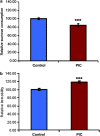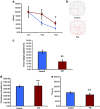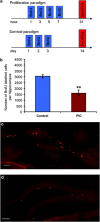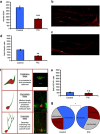Long-term effects of maternal immune activation on depression-like behavior in the mouse
- PMID: 24548878
- PMCID: PMC3944633
- DOI: 10.1038/tp.2013.132
Long-term effects of maternal immune activation on depression-like behavior in the mouse
Abstract
Depression is a debilitating mental disease affecting a large population worldwide, the pathophysiological mechanisms of which remain incompletely understood. Prenatal infection and associated activation of the maternal immune system (MIA) are prominently related to an increased risk for the development of several psychiatric disorders including schizophrenia and autism in the offsprings. However, the role of MIA in the etiology of depression and its neurobiological basis are insufficiently investigated. Here we induced MIA in mice by challenge with polyinosinic:polycytidylic phosphate salt-a synthetic analog of double-stranded RNA, which enhances maternal levels of the cytokine interleukin-6 (IL-6)-and demonstrate a depression-like behavioral phenotype in adult offsprings. Adult offsprings additionally show deficits in cognition and hippocampal long-term potentiation (LTP) accompanied by disturbed proliferation of newborn cells in the dentate gyrus and compromised neuronal maturation and survival. The behavioral, neurogenic and functional deficiencies observed are associated with reduced hippocampal expression of vascular endothelial growth factor (VEGF)A-VEGFR2. IL-6-STAT3-dependent aberrant VEGFA-VEGFR2 signaling is proposed as neurobiological mechanism mediating the effects of MIA on the developing fetal brain and ensuing consequences in adulthood.
Figures





References
-
- Babulas V, Factor-Litvak P, Goetz R, Schaefer CA, Brown AS. Prenatal exposure to maternal genital and reproductive infections and adult schizophrenia. Am J Psychiatry. 2006;163:927–929. - PubMed
-
- Buka SL, Cannon TD, Torrey EF, Yolken RH. Collaborative study group on the perinatal origins of severe psychiatric disorders. Maternal exposure to herpes simplex virus and risk of psychosis among adult offspring. Biol Psychiatry. 2008;63:809–815. - PubMed
-
- Kolevzon A, Gross R, Reichenberg A. Prenatal and perinatal risk factors for autism: a review and integration of findings. Arch Pediatr Adolesc Med. 2007;161:326–333. - PubMed
-
- Mednick SA, Huttunen MO, Machon RA. Prenatal influenza infections and adult schizophrenia. Schizophr Bull. 1994;20:263–267. - PubMed
Publication types
MeSH terms
Substances
Grants and funding
LinkOut - more resources
Full Text Sources
Other Literature Sources
Medical
Miscellaneous

